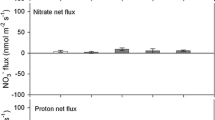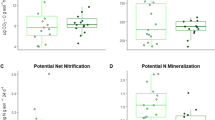Abstract
The ability of trees dependent on arbuscular mycorrhizal (AM) fungi to establish in ectomycorrhizal forests is unknown. On northern Vancouver Island, Canada, there are sharp boundaries between mixed red cedar (Thuja plicata)-hemlock (Tsuga heterophylla) (CH) stands, and stands of hemlock and amabilis fir (Abies amabilis) (HA). We tested differences in AM colonization of red cedar between ectomycorrhiza-dominated (HA) stands and stands containing red cedar (CH), across a range of light levels. We used a soil bioassay approach to determine whether there was sufficient AM fungal inoculum in the HA tree stands to colonize red cedar seedlings. Seeds of hemlock and red cedar were sown in forest floor samples collected from the two types of forests, and shade treatments ranging from <1 to 53% of full sunlight were imposed. After 6 months, seedling survival and root and shoot biomass were quantified, and red cedar seedlings were sampled for AM fungal colonization. Hemlock survival and growth did not differ between soil types, suggesting there was no substrate-associated limitation to its establishment in either forest type. Red cedar colonization by AM fungi was significantly correlated with light levels in CH soils but arbuscular mycorrhizas were absent in roots of red cedar seedlings grown in HA soil. Red cedar survival and relative growth rate were significantly greater in the CH than in HA soil; higher growth was due primarily to greater shoot growth in CH soils at high light levels. The low soil inoculum potential for red cedar in ectomycorrhiza-dominated stands may account for the virtual exclusion of red cedar seedlings from these forests.




Similar content being viewed by others
References
Abbott LK, Robson AD (1991) Factors influencing the occurrence of vesicular-arbuscular mycorrhizas. Agric Ecosyst Environ 35:121–150
Alexander IJ (1989) Mycorrhizas in tropical forests. In: Proctor J (ed) Mineral nutrients in tropical forest and Savannah ecosystems. Blackwell Scientific, Oxford, UK, pp 169–188
Allen MF, Macmahon JA (1988) Direct VA mycorrhizal inoculation of colonizing plants by pocket gophers (Thomomys-talpoides) on Mount-St.-Helens. Mycologia 80:754–756
Allen MF, Crisafulli C, Friese CF, Jeakins SL (1992) Re-formation of mycorrhizal symbioses on Mount St Helens, 1980–1990 - interactions of rodents and mycorrhizal fungi. Mycol Res 96:447–453
Allen EB, Allen MF, Helm DJ, Trappe JM, Molina R, Rincon E (1995) Patterns and regulation of mycorrhizal plant and fungal diversity. Plant Soil 170:47–62
Amaranthus MP, Perry DA (1987) The effect of soil transfers on ectomycorrhizal formation and the survival and growth of conifer seedlings on old, nonreforested clearcuts. Can J For Res 17:944–950
Berch SM, Kendrick B (1982) Vesicular-arbuscular mycorrhizae of southern Ontario ferns and fern allies. Mycologia 74:769–776
Bergemann SE, Miller SL (2002) Size, distribution, and persistence of genets in local populations of the late-stage ectomycorrhizal basidiomycete, Russula brevipes. New Phytol 156:313–320
Borchers S, Perry DA (1987) Early successional hardwoods as refugia for ectomycorrhizal fungi in clearcut Douglas-fir forests of southwest Oregon. In: Sylvia DM, Hung LL, Graham JH (eds) Mycorrhizae in the next decade: practical applications and research priorities. University of Florida, Gainesville, pp 1–85
Brundrett MC (1991) Mycorrhizas in natural ecosystems. In: Macfayden A, Begon M, Fitter AH (eds) Advances in ecological research, vol 21. Academic, London, pp 171–313
Brundrett MC, Abbott LK (1994) Mycorrhizal fungus propagules in the jarrah forest. I. Seasonal study of inoculum levels. New Phytol 127: 539–546
Cooper KM (1976) A field survey of VA mycorrhizas in New Zealand ferns. N Z J Bot 14:169–181
Curran MP, Dunsworth BG (1988) Coastal red cedar regeneration: problems and potentials. In: Smith NJ (ed) Western red cedar-does it have a future? Conference proceedings, Faculty of Forestry, The University of British Columbia, Vancouver, BC pp 20–32
Daft MJ, El-giahmi AA (1978) Effect of defoliation and light on selected hosts. New Phytol 80:365–372
De Montigny L (1992) An investigation into the factors contributing to the growth check of conifer regeneration on northern Vancouver Island. Ph.D. Thesis, Department of Forest Sciences, University of British Columbia, Vancouver, BC
Ferguson JJ, Menge JA (1982) The influence of light intensity and artificially extended photoperiod upon infection and sporulation of Glomus fasciculatus on sudan grass and on root exudation of sudan grass. New Phytol 92:183–191
Fitter AH (1992) Roots. In: Davis B, Walker N, Ball D, Fitter A (eds) The soil. Harper Collins, London, pp 45–56
Francis R, Read DJ (1994) The contributions of mycorrhizal fungi to the determination of plant community structure. Plant Soil 159:11–25
Gehring CA (2003) Growth responses to arbuscular mycorrhizae by rain forest seedlings vary with light intensity and tree species. Plant Ecol 167:127–139
Gehring CA, Wolf JE, Theimer TC (2002) Terrestrial vertebrates promote arbuscular mycorrhizal fungal diversity and inoculum potential in a rain forest soil. Ecol Lett 5:540–548
Gemma JN, Koske RE, Flynn T (1992) Mycorrhizae in Hawaiian pteridophytes: occurrence and evolutionary significance. Am J Bot 79:843–852
Hagerman S, Sakakibara S, Durall, D (2001) The potential role for woody understorey plants to provide refuge for ectomycorrhizal inoculum at an interior Douglas-fir forest after clear- cut logging. Can J For Res 31:711–721
Hartnett DC, Wilson GW (1999) Mycorrhizae influence plant community structure and diversity in tallgrass prairie. Ecology 80:1187–1195
Hayman DS (1974) Plant growth responses to vesicular-arbuscular mycorrhiza. New Phytol 73:71–80
Hebda RJ (1983) Late glacial and postglacial vegetation history at Bear Cove Bog northeast Vancouver Island British Columbia Canada. Can J Bot 61:3172–3192
van der Heijden MGA, Boller T, Wiemken A, Sanders IR (1998a) Different arbuscular mycorrhizal fungal species are potential determinants of plant community structure. Ecology 79:2082–2091
Helgason T, Merryweather JW, Denison J, Wilson P, Young JPW, Fitter AH (2002) Selectivity and functional diversity in arbuscular mycorrhizas of co-occurring fungi and plants from a temperate deciduous woodland. J Ecol 90:371–384
van der Hiejden MGA, Klironomos JN, Ursic M, Moutoglis P, Streitwolf-Engel R, Boller T, Wiemken A, Sanders IR (1998b) Mycorrhizal fungal diversity determines plant biodiversity, ecosystem variability and productivity. Nature 396:69–72
Horton TR, Bruns TD (1998) Multiple-host fungi are the most frequent and abundant ectomycorrhizal types in a mixed stand of Douglas fir (Pseudotsuga menziesii) and bishop pine (Pinus muricata). New Phytol 139:331–339
Horton TR, Bruns TD, Parker VT (1999) Ectomycorrhizal fungi associated with Arctostaphylos contribute to Pseduotsuga menziesii establishment. Can J Bot 77:93–102
Husband R, Herre EA, Turner SL, Gallery R, Young JPW (2002) Molecular diversity of arbuscular mycorrhizal fungi and patterns of host association over time and space in a tropical forest. Mol Ecol 11:2669–2678
Jones MJ, Durall DM, Cairney JWG (2003) Ectomycorrhizal fungal communities in young forest stands regenerating after clearcut logging. New Phytol 157:399–422
Kleinbaum DG, Kupper LL (1978) Applied regression analysis and other multivariate methods, 1st edn. Duxbury, North Scituate, Mass., USA
Klironomos JN (2003) Variation in plant response to native and exotic arbuscular mycorrhizal fungi. Ecology 84:2292–2301
Kough J, Molina R, Linderman R (1985) Mycorrhizal responsiveness of Thuja, Calocedrus, Sequoia and Sequoiadendron species of western North America. Can J For Res 15:1049–1054
Kovacic DA, St. John TV, Dyer MI (1984) Lack of vesicular-arbuscular mycorrhizal inoculum in a ponderosa pine forest. Ecology 65:1755–1759
Kretzer AM, Dunham S, Molina R, Spatafora JW (2004) Microsatellite markers reveal the below ground distribution of genets in two species of Rhizopogon forming tuberculate ectomycorrhizas on Douglas fir. New Phytol 161:313–320
Lewis T (1982) Ecosystems of the Port McNeill block (block 4) of tree farm license 25. Internal report. Western Forest Products, Vancouver, BC
Lovelock CE, Andersen K, Morton JB (2003) Arbuscular mycorrhizal communities in tropical forests are affected by host tree species and environment. Oecologia 135:268–279
Miller SL, Allen EB (1992) Mycorrhizae, nutrient translocation, and interactions between plants. In: Allen MF (ed) Mycorrhizal functioning. Chapman & Hall, New York, USA, pp 301–332
Molina R, Massicotte H, Trappe JM (1992) Specificity phenomena in mycorrhizal symbiosis: community-ecological consequences and practical implications. In: Allen MF (ed) Mycorrhizal functioning. Chapman & Hall, New York, USA, pp 357–423
Moser M (1967) Die ectotrophe Ernährungsweise an der Waldgrenze. Mitt Forstl Bundesversuchsanst. Wien 75:357–380
Moyersoen B, Fitter AH, Alexander IJ (1998) Spatial distribution of ectomycorrhizas and arbuscular mycorrhizas in Korup National Park rain forest, Cameroon, in relation to edaphic parameters. New Phytol 139:311–320
Neter J, Kutner M, Nachtsheim C, Wasserman W (1996) Applied linear statistical models, 4th edn. Irwin, USA
O’Connor PJ, Smith SE, Smith FA (2002) Arbuscular mycorrhizas influence plant diversity and community structure in a semiarid herbland. New Phytol 154:209–218
Onguene NA, Kuyper TW (2002) Importance of the ectomycorrhizal network for seedling survival and ectomycorrhiza formation in rain forests of south Cameroon. Mycorrhiza 12:13–17
Overpeck JT, Bartlein PJ, Webb T (1991) Potential magnitude of future vegetation change in eastern North America-comparisons with the past. Science 254:692–695
Parent S, Messier C (1996) A simple and efficient method to estimate microsite light availability under a forest canopy. Can J For Res 26:151–154
Parmesan C, Yohe G (2003) A globally coherent fingerprint of climate change impacts across natural systems. Nature 421:37–42
Perry DA, Amaranthus MP, Borchers JG, Borchers SL, Brainerd RE (1989) Bootstrapping in ecosystems. Bioscience 39:230–237
Prescott C, Weetman G (1994) Salal red cedar hemlock. Integrated research program: a synthesis. Faculty of forestry, The University of British Columbia, Vancouver, BC
Prescott CE, McDonald MA, Weetman GF (1993) Availability of N and P in the forest floors of adjacent stands of western red cedar-western hemlock and western hemlock-amabilis fir on northern Vancouver Island. Can J For Res 23:605–610
Read DJ (1991) Mycorrhizas in ecosystems. Experientia 47:376–391
Read DJ (1992) The mycorrhizal mycelium. In: Allen MF (ed) Mycorrhizal functioning. New Chapman & Hall, New York, USA, pp 102–133
Reynolds HL, Packer A, Bever JD, Clay K (2003) Grassroots ecology: plant-microbe-soil interactions as drivers of plant community structure and dynamics. Ecology 84:2281–2291
Sanders IR (2002) Specificity in the arbuscular mycorrhizal symbiosis. In: van der Heijden MGA, Sanders I (eds) Mycorrhizal ecology. Ecological studies analysis and synthesis, vol 157. Springer, Berlin Heidelberg New York, pp 415–440
SAS (1999) The SAS system for windows. Version 8.02. SAS Institute, Cary, N.C., USA
Terwilliger J, Pastor J (1999) Small mammals, ectomycorrhiza and conifer succession in beaver meadows. Oikos 85:83–94
Trappe JM (1989) The meaning of mycorrhizae to plant ecology. In: Mahadevan M, Ramen N, Natarayan K (eds) Mycorrhizae for green Asia. Centre for Advanced Studies. University of Madras, India, pp 347–349
Urcelay C, Diaz S (2003) The mycorrhizal dependence of subordinates determines the effects of arbuscular mycorrhizal fungi on plant diversity. Ecol Lett 6:388–391
Vandenkoornhuyse P, Ridgway KP, Watson IJ, Fitter AH, Young JPW (2003) Co-existing grass species have distinctive arbuscular mycorrhizal communities. Mol Ecol 12:3085–3095
Weber AB, Gilbert B, Kimmins JP, Prescott CE (2003) Factors limiting the early survivorship of Thuja plicata on northern Vancouver Island, British Columbia. Can J For Res 33:854–861
Zhi-wei Z (2000) The arbuscular mycorrhizas of pteridophytes in Yunnan, southwest China: evolutionary interpretations. Mycorrhiza 10:145–149
Acknowledgements
This paper is dedicated to the memory of Adrian Weber. Thank you to Jennifer Bennett, Shannon Berch, Leandra Blevins and Cindy Prescott for advice on experimental design and analysis. We thank Sara Leckie, Melanie Jones and Roy Turkington for comments on earlier drafts. This experiment complied with current Canadian laws.
Author information
Authors and Affiliations
Corresponding author
Additional information
Adrian Weber: Deceased
Rights and permissions
About this article
Cite this article
Weber, A., Karst, J., Gilbert, B. et al. Thuja plicata exclusion in ectomycorrhiza-dominated forests: testing the role of inoculum potential of arbuscular mycorrhizal fungi. Oecologia 143, 148–156 (2005). https://doi.org/10.1007/s00442-004-1777-y
Received:
Accepted:
Published:
Issue Date:
DOI: https://doi.org/10.1007/s00442-004-1777-y




